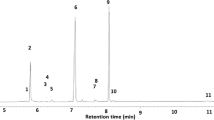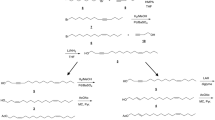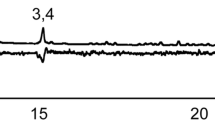Abstract
Three major components, ethyi-(E)-3-octenoate, geranyl acetate, and (E,E)-α-farnesene, emitted as volatiles by laboratory-reared and wild male medflies were collected and analyzed qualitatively and quantitatively. Peak emission of these compounds occurred during the third to fifth hours of the photophase and differences were observed in the ratios of the three components emitted by male laboratory-reared and wild flies. These three compounds were synthesized, and a method was developed to formulate a synthetic blend that released the compounds in a ratio similar to that emitted by wild male medflies. Attractiveness of the blend to female medflies was demonstrated under field conditions by comparing trap catches. Black spherical traps, baited with the synthetic blend to release 1.6 male equivalents, caught significantly more females than blank traps and traps from which the blend released was 0.3, 3.2 or 6.4 male equivalents.
Similar content being viewed by others
References
Baker, P.S., Howse, P.E., Ondarza, R.N., andReyes, J. 1990. Field trials of synthetic sex pheromone components of the male Mediterranean fruit fly (Diptera: Trypetidae) in Mexico,J. Econ. Entomol. 6:2236–2245.
Baker, R., Herbert, R.H., andGrant, G.G. 1985. Isolation and identification of the sex pheromone of the Mediterranean fruit fly,Ceratitis capitata (Wied.).J. Chem. Soc. Chem. Commun. 1985:824–825.
Beroza, M., Green, N., Gertler, S.I., Steiner, L.F., andMiyashita, D.H. 1961. Insect attractants. New attractants for the Mediterranean fruit fly.J. Agric. Food Chem. 9:361–365.
Brandsma, L. 1971. Page 120,in L. Brandsma (ed.). Preparative Acetylenic Chemistry. Elsevier, New York.
Calzada, I.G., andHooz, I. 1974. Geranyl chloride [(E)-1-chloro-3,7-dimethyl-2,6-octadiene].J. Org. Synth. 54:63–67.
Dowell, R.V., andWange, L.K., 1986. Process analysis and failure avoidance in fruit fly programs, pp. 43–65,in M. Mangel, J.R. Carey, and R.E. Plant (eds.). Pest Control. NATO ASI Series, Springer-Verlag, New York.
Duncan, D.B., 1955. Multiple range and multipleF tests.Biometrics 11:1–41.
Féron, M. 1962. L'instinct de reproduction chez la mouche Mediterranéene des fruitsCeratitis capitata Wied. (Diptera: Trypetidae). Comportement sexuel-comportement de ponte.Rev. Pathol. Veg. Entomol. Agric. Fr. 41:1–129.
Harris, E.J., Nakagawa, S., andUrago, T. 1971. Sticky traps for detection and survey of three tephritids.J. Econ. Entomol. 64:62–65.
Heath, R.R., Tumlinson, J.H., Doolittle, R.E., andDuncan, J.H. 1977. Analytical and preparative separation of geometrical isomers by high efficiency silver nitrate liquid chromatography.J. Chromatogr. Sci. 15:10–13.
Heath, R.R., Teal, P.E.A., Tumlinson, J.H., andMengelkoch, L.J. 1986. Prediction of release ratios of multicomponent pheromones from rubber septa.J. Chem. Ecol. 12(12):2133–2143.
Jacobson, J., Ohinata, K., Chambers, D.L., Jones, W.A., andFujimoto, M.S. 1973. Insect sex attractants. 13. Isolation, identification and synthesis of sex pheromones of the male Mediterranean fruit fly.J. Med. Chem. 16:248–251.
Jang, E.G., Light, D.M., Flath, R.A., Nagata, J.T., andMon, T.R. 1989. Electroantennogram responses of the Mediterranean fruit fly,Ceratitis capitata to identified volatile constituents from calling males.Entomol. Exp. Appl. 50(1):7–19.
Landolt, P.J., andHeath, R.R. 1987. Role of female-produced sex pheromone in behavioral reproductive isolation betweenTrichoplusia ni (Hübner) andPseudoplusia includens (Walker) (Lepidoptera: Noctuidae, Plusiinae).J. Chem. Ecol. 13:1005–1018.
Landolt, P.J., andHeath, R.R. 1990. Effects of pheromone release rate and time of day on catches of male and female papaya fruit flies (Diptera: Tephritidae) on fruit-model traps baited with pheromone.J. Econ. Entomol. 83:2040–2043.
Landolt, P.J., Heath, R.R., Agee, H.R., Tumlinson, J.H., andCalkins, C.O. 1988. A sex pheromone-based trapping system for the papaya fruit fly,Toxotrypana curvicauda Gerstaecker (Diptera: Tephritidae).J. Econ. Entomol. 81(4): 1163–1169.
Nakagawa, S., Farias, G.J., andSteiner, L.F. 1970. Response of female Mediterranean fruit flies to male lures in the relative absence of males.J. Econ. Entomol. 63:227–229.
Nakagawa, S., Prokopy, R.J., Wong, T.T., Ziegler, J.R., Mitchell, S.M., Urago, T., andHarris, E.J. 1978. Visual orientation ofCeralitis capitata flies to fruit models.Entomol. Exp. Appl. 24:193–198.
Negishi, E., andMatsushita, H. 1984. Palladium-catalyzed synthesis of 1,4-dienes by allylation of alkenylalanes: α-Farnesene (1,2,6,10-dodecatetraene, 3,7,11-trimethyl).Org. Synth. 62:31–38.
Tumlinson, J.H.,Teal, P.E.A., andHeath, R.R. 1981. Chemical ethology: A holistic approach to the study of insect pheromones, pp. 19–31,in Proceedings 1st Japan/USA Symposium on IPM. Tsukuba, Japan, September 29–30.
Weatherston, I.,Miller, D., andDohse, L. 1984. Release of volatile materials from glass capillaries-α reinvestigation, pp. 114–115,in Proceedings 11th International Symposium Controlled Release Bioactive Materials. Fort Lauderdale, Florida.
Weatherston, I., Miller, D., andDohse, L. 1985a. Capillaries as controlled release devices for insect pheromones and other volatile substances-α reevaluation: Part I. Kinetics and development of predictive model for glass capillaries.J. Chem. Ecol. 11:953–965.
Weatherston, I., Miller, D., andLavoi-Dornik, J. 1985b. Capillaries as controlled release devices for insect pheromones and other volatile substances—a reevaluation: Part II. Predicting release rates from Celcon and Teflon capillaries.J. Chem. Ecol. 11:967–968.
Author information
Authors and Affiliations
Additional information
This article reports the results of research only. Mention of a proprietary product does not constitute an endorsement or recommendation for its use by USDA.
Rights and permissions
About this article
Cite this article
Heath, R.R., Landolt, P.J., Tumlinson, J.H. et al. Analysis, synthesis, formulation, and field testing of three major components of male mediterranean fruit fly pheromone. J Chem Ecol 17, 1925–1940 (1991). https://doi.org/10.1007/BF00993739
Received:
Accepted:
Issue Date:
DOI: https://doi.org/10.1007/BF00993739




